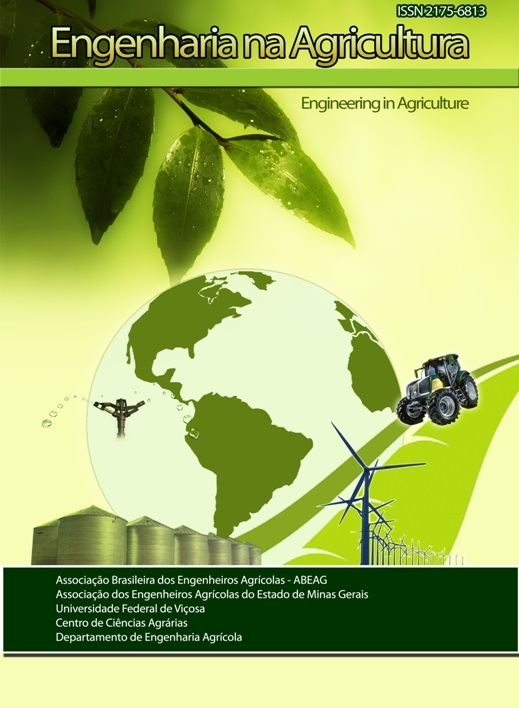Control system for complete burning in furnace using lambda probe
DOI:
https://doi.org/10.13083/reveng.v28i.903Palavras-chave:
heated air, process control, instrumentation, grain storageResumo
The objective of this work was to evaluate the biomass burning process in a furnace, using chip as a raw material and an oxygen sensor (lambda probe) to monitor the percentage of oxygen in the gases exhausted during combustion, aiming to maintain the percentage of the coefficient of excess air (?) in the operating range of 1.20 to 1.25%, considered ideal for the biomass (chip) used in the study. Once the excess air is identified at the upper furnace exit, the air entrance in the system will be closed by means of a butterfly valve using a servo motor driven by a Programmable Logic Controller (PLC). The valve was opened or closed according to the oxygen level; when it was lower than 1.20%, the door remained open, and it was closed when the level reached 1.25%, finishing the cycle of the process. The open and closed states of the valve occurred by means of two reed switch magnetic key sensors installed in the air intake system. For the control, monitoring and data acquisition, a supervisory system created using the Elipse SCADA software was used so it was possible to obtain a system database, which will provide important information to maximize the efficiency of the furnace.
Downloads
Referências
BLASEUBAUER, H. Combustão de Madeira e Controle de Poluição em Cerâmicas. Revista NovaCer, Criciúma, v.5, p.63-67, 2010.
CAPOSCIUTTI, G.; ANTONELLI, M. Experimental investigation on air displacement and air excess effect on CO, CO2 and NOx emissions of a small size fixed bed biomass boiler. Renewable Energy, v.116, p.95-804, 2018.
CERON, L.P. Controle de excesso de ar em processos de combustão. Revista Meio Filtrante, v.44, p.40-46, 2010.
CONAMA- CONSELHO NACIONAL DO MEIO AMBIENTE. Resolução N° 382/2006. Estabelece os limites máximos de emissão de poluentes atmoféricos para fontes fixas. Brasília, DOU, dezembro de 2006.
CONAMA- CONSELHO NACIONAL DO MEIO AMBIENTE. Resolução N° 436/2011. Estabelece os limites máximos de emissão de poluentes atmosféricos para fontes fixas instaladas ou com pedido de licença de instalação anteriores a 02 de janeiro de 2007. Brasília, DOU, dezembro de 2011.
GIL, W.; CARVALHO, J.A.; BASTOS-NETTO, D. Termodinâmica da Combustão. 1987, Instituto Nacional de Pesquisas Espaciais, São José dos Campos SP.
LOPES, R.P. OLIVEIRA Filho, D.; DONZELES, S.M.L.; FERREIRA, W.P.M. Controle da combustão em fornalhas a lenha. An. 3. Enc. Energ. Meio Rural 2003, Viçosa, 2003.
NETO, J.M.; Controle Simultâneo de Temperatura e Estequiometria Aplicado em um Secador Vertical de Revestimentos Cerâmicos Alimentado com Gás Natural. Dissertação (Mestrado em Engenharia Mecânica) – Universidade Federal do Rio Grande do Sul, Porto Alegre, 2008.
PEDRUZI, G.O.L, Controle de Nível de Tanques Conectados Utilizando CLP CLIC-02 e ELIPSE SCADA; Monografia (Bacharel em Engenharia Elétrica) - Departamento de Engenharia Elétrica, Universidade Federal de Viçosa. Viçosa, 2014.
PRECCI, R.L.; SOBRINHO, J.C.; SILVA, J.S.; SILVA, J.N. Fontes de Energia para Secagem. Associação dos Engenheiros Agrícolas de Minas Gerais/UFV, DEA, 2001. 26P. : il. ( Engenharia na Agricultura. Boletim técnico; 3).
RAMAVANDI, B.; ASGARI, G. Comparative study of sun-dried and oven-dried Malva sylvestris biomass for high-rate Cu(II) removal from wastewater. Process Safety And Environmental Protection, v.116, p.61-73, 2018.
?AHIN, F. Effects of engine parameters on ionization current and modeling of excess air coefficient by artificial neural network. Applied Thermal Engineering, v.90, p.94-101, 2015.
WANG, Z.; LI, J.; LAI, C. Drying tendency dominating the global grain production area. Global Food Security, v.16, p.138-149, 2018.
Downloads
Publicado
Como Citar
Edição
Seção
Licença
Copyright (c) 2020 REVISTA ENGENHARIA NA AGRICULTURA - REVENG

Este trabalho está licenciado sob uma licença Creative Commons Attribution-NonCommercial 4.0 International License.
Autores que publicam nesta revista concordam com os seguintes termos:
O(s) autor(es) autoriza(m) a publicação do texto na da revista;
O(s) autor(es) garantem que a contribuição é original e inédita e que não está em processo de avaliação em outra(s) revista(s);
A revista não se responsabiliza pelas opiniões, ideias e conceitos emitidos nos textos, por serem de inteira responsabilidade de seu(s) autor(es);
É reservado aos editores o direito de proceder a ajustes textuais e de adequação às normas da publicação.
A partir da submissão, o autor estará cedendo integralmente seus direitos patrimoniais da obra à publicação, permanecendo detentor de seus direitos morais (autoria e identificação na obra) e de acordo com a Licença Creative Commons, CC BY-NC.








 Esta obra está licenciada com uma Licença
Esta obra está licenciada com uma Licença 